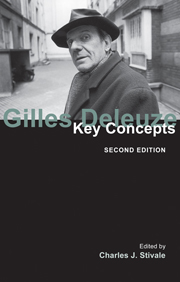15 - Folds and folding
from Part III - FOLDS
Summary
Folds and folding count among the most vital and resonant terms in Deleuze's copious and varied writings. The modest monosyllable, “pli”, that refers both to a twist of fabric and to the origins of life, bears a lightness and density that mark many of the philosopher's reflections on questions of being and on the nature of events. Like the “events” of May 1968 in Paris, in 1988 the publication of Le Pli: Leibniz et le baroque (The Fold: Leibniz and the Baroque) became an event in itself and has since been a point of reference for the oeuvre in general. The intention behind the book, states the terse endnote on the back cover, is to show how, in the Baroque age that extends from the Counter Reformation to the Neo-Baroque in contemporary times, the fold can be taken as a figure and a form bearing almost infinite conceptual force. Leibniz's philosophy of the monad can be labelled “Baroque” because in the world of his fragmentary writing “everything folds, unfolds, refolds” (Deleuze, Le Pli, back cover). The soul is conceived as a monad, an enclosed space in a room without either doors or windows that draws its “clear perceptions” from a dark background (Le Pli, back cover). Deleuze notes that the German philosopher's response to the Cartesian concept of the soul can be understood only by analogy with the inside of a Baroque chapel, whose inner walls are erected with slabs of black marble.
- Type
- Chapter
- Information
- Gilles DeleuzeKey Concepts, pp. 192 - 203Publisher: Acumen PublishingPrint publication year: 2011

